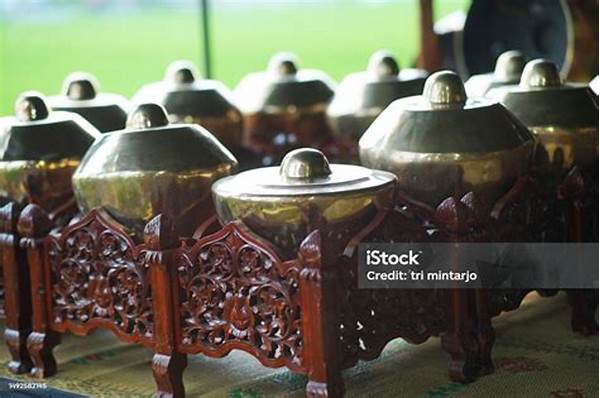Picture yourself sitting under a starlit Javanese sky, surrounded by a symphony of high-pitched gongs and hypnotic rhythms. An intricately carved wooden screen separates you from a fantastical world where elaborate puppets dance to narrate epic tales. This isn’t just any performance; it’s the iconic Wayang Kulit show, where the bonang, an intricate, multi-layered set of small gongs, takes center stage. This musical gem doesn’t just set the tempo; it evokes emotions and breathes life into each puppet character.
Read More : Best Instrument Indonesia Gong Ageng Symbolizing Spiritual Ceremonies
The bonang is more than just a musical instrument; it’s the heartbeat of the wayang, the Javanese puppet theater. Unlike any modern-day DJ equipment, the bonang’s allure is in its robustness and timelessness. It holds together the entire gamut of ancient musical art, creating a rich tapestry of sound that has mesmerized generations. Are you intrigued by this piece of musical heritage that stands the test of time, while also attracting the younger generation with its captivating sounds? You should be!
The Role of Bonang in Wayang Kulit
Unlike any automated light and sound system of today, the bonang in Wayang Kulit acts as both a soundtrack and a sound effect provider. Its function transcends mere entertainment; it envelops the audience in a spellbinding narrative. Sitting in coordinated pairs and arranged by pitch, these small, knobbed gongs deliver resonant, heart-thumping rhythms that guide the dhalang, or puppet master, through the intricate storytelling. The musicians adeptly strike the surface to create cascading melodies, skillfully manipulating the drama’s intensity.
The bonang comprises several rows, each possessing a unique tonal quality that contributes to the ensemble’s orchestra. The interesting part is how the instrument doesn’t play solo but rather integrates itself smoothly into the larger gamelan orchestra, acting as a vivid storyteller. It commands without overpowering, completing the dynamic interplay of the scene and ensuring each beat of the shadow play reaches its dramatic zenith.
The Unique Sound of Bonang
The bonang’s distinctive notes bring an emotional layer to the theater. Imagine sitting in the wooden amphitheater, with shadows flickering against the brightly lit screen, each beat of the bonang pulling at your heartstrings. The sound is both familiar and new, evoking a sense of nostalgia yet maintaining a fresh allure that keeps new audiences coming back for more.
Interestingly, each bonang is uniquely tuned, ensuring every performance is a one-of-a-kind auditory experience. Musicologists often describe the sound as vibrant, yet soothing—a juxtaposition that captures the duality of the Wayang Kulit narratives, which often balance humor with moral lessons. This dual capability is what has made the bonang enduringly relevant and versatile in modern adaptations of traditional plays.
Exploring Bonang’s Impact
If you’re ever in Indonesia, catching a Wayang Kulit performance provides a cultural portal into an ancient world. But it’s more than just a leisurely activity; it’s an educational experience. Adding a bonang-focused discussion into educational curriculums can cultivate a global appreciation of this cultural relic, fostering a richer understanding of the tapestry of humanity’s artistic history.
How to Experience Bonang Live
1. Attend a Cultural Festival: Indonesia hosts several festivals showcasing Wayang Kulit. It’s a fantastic opportunity to experience the bonang firsthand.
2. Visit Museums and Exhibitions: Many cultural museums provide exhibits showcasing historical and modern bonang displays.
Read More : Recommended Hand Percussion Instruments For Cafe Acoustic Music
3. Enroll in Gamelan Workshops: Various cultural organizations offer gamelan, including bonang workshops, letting you touch, play, and feel the sound for an immersive experience.
The Educational Value
Including the bonang and its role in Wayang Kulit as part of a musical curriculum allows for a multi-dimensional learning experience. Students not only appreciate the historical context but also learn critical listening and rhythmic skills. This comprehensive understanding fosters creativity as students explore how traditional and modern music interrelates.
—
Key Takeaways of Bonang’s Role
The bonang is not just an instrument, but an interactive piece of cultural narrative, breathing soul into centuries-old tales with its shimmering timbre. Its central role in shadow puppet theater is indispensable, offering an avenue for both performance and academic exploration. This rich cultural tapestry is more than an anachronism; it’s a living tradition that continues to be relevant and revered.
Conclusion
In the end, the bonang is more than just a part of Indonesia’s cultural identity. It’s a bridge that connects the richness of the past with the contemporary urge to innovate, ensuring that the mesmerizing art of shadow puppetry remains a cherished spectacle for future generations. Engage with the bonang and witness how it continues to shape and enrich Indonesia’s cultural landscape, one resonant note at a time. Be sure to tap into this well of tradition and experience this unique art form for yourself.
